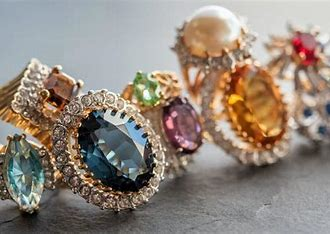


Here are some low-cost DIY product ideas you can create and sell to profit from in 2025:
1. Eco-friendly Reusable Bags
- Materials Needed: Fabric scraps, sewing machine or hand-sewing kit, thread, handles (optional).
- Why It Works: Sustainability is a growing trend, and consumers are more inclined to buy eco-friendly products. Reusable bags are practical, stylish, and can be sold at affordable prices.
2. Personalized Candles
- Materials Needed: Wax, fragrance oils, wicks, molds, dye, jars or containers, labels.
- Why It Works: Custom candles are popular for gifts and home décor. You can create unique designs and scents for special occasions like birthdays, holidays, and weddings.
3. Handmade Soap
- Materials Needed: Soap base, natural oils (like olive or coconut), essential oils, colorants, molds.
- Why It Works: Organic and handmade soaps have a strong market demand. You can offer different varieties like moisturizing, exfoliating, or even themed soaps for special occasions.
4. Custom Mugs
- Materials Needed: Blank mugs, vinyl stickers or heat transfer paper, printer, cutting machine.
- Why It Works: Personalized items are always in demand, and custom mugs can cater to a wide variety of niches, from funny quotes to inspirational messages and custom designs for businesses.
5. Upcycled Furniture
- Materials Needed: Old furniture pieces, paint, sandpaper, fabric (for reupholstering), tools.
- Why It Works: People love unique, vintage pieces with character. Repurposing old furniture and giving it a new life with a fresh coat of paint or new upholstery can appeal to eco-conscious customers looking for affordable home décor.
6. Handcrafted Jewelry
- Materials Needed: Beads, wire, chains, clasps, pliers, gemstones, resin, and charms.
- Why It Works: Jewelry is a timeless accessory, and handmade items have a special appeal. You can create simple yet stylish pieces such as earrings, necklaces, bracelets, or rings that cater to different styles and preferences.
7. Plant Pots and Planters
- Materials Needed: Clay pots, paint, decorative items (e.g., twine, pebbles), and sealant.
- Why It Works: Indoor plants are trending, and people love having stylish planters. You can make creative, personalized planters or upcycle old items into unique plant pots.
8. DIY Home Decor Items
- Materials Needed: Wood, paints, stencils, glue, nails, fabric.
- Why It Works: There’s a strong market for handmade home décor like wall hangings, picture frames, dream catchers, and custom signs. These can be personalized for special occasions like weddings, housewarmings, or holidays.
9. Handmade Scrunchies or Hair Accessories
- Materials Needed: Fabric, elastic bands, sewing machine or hand-sewing kit.
- Why It Works: Hair accessories like scrunchies are popular, especially with the ongoing 90s nostalgia. You can create different fabric designs to match different tastes and trends.
10. Custom T-Shirts or Apparel
- Materials Needed: Blank t-shirts, vinyl, heat press or iron, design software (optional).
- Why It Works: Custom apparel has always been a hot trend. You can design shirts, hoodies, or hats with unique graphics, slogans, or logos that appeal to niche audiences or broader trends.
11. Pet Products (Toys, Beds, etc.)
- Materials Needed: Fabric, stuffing, thread, toys, cotton, or other pet-safe materials.
- Why It Works: Pet owners love pampering their pets. Creating affordable, cute, and functional pet accessories like beds, toys, or even pet clothing could be a lucrative niche market.
12. Handmade Greeting Cards
- Materials Needed: Paper, stamps, ink, markers, embellishments.
- Why It Works: With the rise of personalized gifts, greeting cards with unique designs or custom messages have a constant demand, especially during holidays, birthdays, or special milestones.
13. Handmade Bath Bombs
- Materials Needed: Baking soda, citric acid, Epsom salt, essential oils, molds, food coloring.
- Why It Works: Bath bombs are affordable and easy to make, and they’ve become popular as relaxation products. You can offer them in various scents, colors, and designs.
14. Upcycled Clothing or Denim
- Materials Needed: Old jeans, fabric paint, embroidery thread, patches, sequins.
- Why It Works: Sustainability and thrifted fashion are in demand. Repurposing old clothing into trendy, one-of-a-kind pieces like custom jackets or patched-up jeans can appeal to eco-conscious and fashion-forward customers.
15. Homemade Snacks (Granola, Energy Bars, etc.)
- Materials Needed: Oats, nuts, dried fruits, honey, chocolate, packaging.
- Why It Works: People are always looking for healthier snack options, especially those that are homemade and nutritious. You can experiment with different flavors and cater to various dietary needs (vegan, gluten-free, etc.).
16. Essential Oils or Aromatherapy Products
- Materials Needed: Essential oils, diffusers, roller bottles, dried flowers, wax for candles.
- Why It Works: Wellness and self-care products are a growing market. You can create your own line of essential oils or aromatherapy products that help customers relax or energize.
17. DIY Natural Beauty Products
- Materials Needed: Aloe vera, coconut oil, beeswax, honey, sugar, essential oils.
- Why It Works: Natural beauty products like lip balms, scrubs, and lotions have a dedicated audience. You can create small batches with simple, clean ingredients and sell them online or at local markets.
By focusing on quality, uniqueness, and customer experience, these low-cost DIY product ideas can help you build a profitable business in 2025.
- DIY Crafts: Your Gateway to Ecommerce
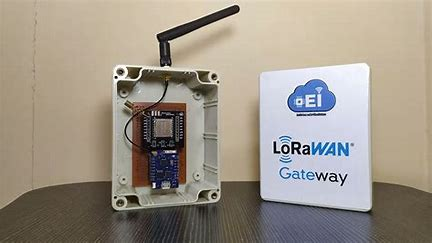
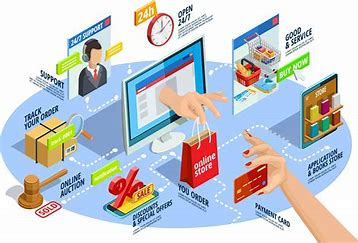
DIY Crafts: Your Gateway to Ecommerce
In recent years, the world of DIY crafts has exploded, and it’s not just for personal enjoyment anymore. With the rise of ecommerce, crafting has become a lucrative business opportunity for many creators. Whether you’re a seasoned crafter or a beginner looking to monetize your passion, ecommerce can be your gateway to turning your DIY skills into a thriving business.
Here’s how DIY crafts can help you break into the ecommerce world and turn your creative passion into a profitable venture:
1. Identify Your Niche
One of the first steps in creating a successful ecommerce business for your DIY crafts is identifying your niche. Think about what you love making and what others might want to buy. Some examples of popular craft niches include:
- Home Décor: Handmade candles, wooden signs, or macramé wall hangings.
- Fashion Accessories: Custom jewelry, knitted scarves, or embroidered hats.
- Eco-friendly Products: Reusable bags, handmade soap, or bamboo products.
- Personalized Gifts: Custom mugs, greeting cards, or engraved items.
The more specific your niche, the easier it will be to target your audience and stand out in a crowded marketplace.
2. Create High-Quality Products
To succeed in ecommerce, your products must be well-crafted and stand out from the competition. Here are some tips to ensure quality:
- Use Quality Materials: Whether you’re making candles or crocheting a sweater, ensure you’re using high-quality materials. It’s an investment in your products that will result in happy customers.
- Pay Attention to Detail: Your craftsmanship should be top-notch. Buyers appreciate attention to detail, and it’s this quality that will encourage repeat business.
- Innovative Designs: Bring fresh ideas into your products. Offer variations or customizable options that appeal to different tastes.
3. Build an Online Store
Once you’ve perfected your craft and found your niche, it’s time to set up an online store. Some popular ecommerce platforms to consider are:
- Etsy: Perfect for handmade and unique items, Etsy has a massive community of buyers who are specifically looking for crafts and artisanal goods.
- Shopify: If you want to create your own independent website, Shopify is a great platform for building a professional online store with customizable options.
- eBay: While known for auctions, eBay can also be a platform for selling DIY products to a wide audience.
- Amazon Handmade: A good option if you want to tap into Amazon’s massive customer base but still maintain the handmade feel of your products.
Make sure your store design is visually appealing, easy to navigate, and showcases your products in the best possible light.
4. Photography and Presentation Matter
High-quality photos are essential when selling DIY crafts online. Since customers can’t physically touch or try your products, pictures are their first impression of your craft. Here are some tips:
- Natural Lighting: Take your photos in natural light or invest in affordable lighting kits to make your products look their best.
- Showcase the Details: Take close-up shots to highlight the fine details of your craftsmanship.
- Contextual Shots: Show your products in use. For example, if you’re selling handmade mugs, photograph them with coffee inside, placed on a stylish table.
5. Pricing Your Crafts
Pricing can be tricky, but it’s essential to get it right to maintain a profitable business. Here’s a general guideline to help you:
- Cost of Materials: Consider how much you spend on materials for each item.
- Labor Costs: Factor in your time. This can be tricky with DIY crafts, but you need to account for how many hours it takes to create the product.
- Overhead and Shipping: Don’t forget to consider packaging materials, website hosting, and shipping costs.
- Market Research: Look at competitors in your niche and see what they’re charging. You can adjust based on the value you provide and your target market.
6. Promote Your Crafts
Once your store is up and running, it’s time to spread the word. Ecommerce relies heavily on digital marketing to reach potential customers. Here are a few marketing ideas:
- Social Media: Platforms like Instagram, Pinterest, and Facebook are great for showcasing DIY crafts. Post regularly, use relevant hashtags, and engage with your followers.
- Content Marketing: Start a blog or YouTube channel where you share crafting tutorials, behind-the-scenes footage of your process, or tips for others. This can drive traffic to your store and build a loyal community.
- Email Marketing: Build an email list and send out newsletters to inform your customers about new products, promotions, or special offers.
7. Focus on Customer Experience
Customer satisfaction is key to growing your ecommerce business. Here are some ways to provide excellent service:
- Timely Shipping: Ensure you ship orders quickly and reliably. Consider offering free or discounted shipping for repeat customers.
- Personalized Touch: Add a personal note or a small freebie with each order to make customers feel special.
- Customer Support: Respond to customer inquiries promptly and professionally. Offering excellent customer service can turn first-time buyers into loyal fans.
8. Expand and Scale Your Craft Business
Once you’ve established your brand and have a steady flow of orders, consider ways to expand:
- Collaborate with Influencers: Partner with social media influencers who align with your brand to showcase your products.
- Offer Customization: Offer personalized versions of your products for gifts or special occasions.
- Diversify: Experiment with new product lines or different craft techniques to keep your offerings fresh and exciting.
9. Keep Up with Trends
To stay competitive, it’s essential to keep an eye on industry trends and adapt accordingly. For example, if you notice a rise in interest for sustainable or eco-friendly crafts, you can pivot to create more eco-conscious products.
Final Thoughts
DIY crafts and ecommerce are a perfect match. By identifying your niche, crafting high-quality products, and using effective marketing strategies, you can turn your passion for crafting into a profitable online business. The world of ecommerce is vast, and with dedication and creativity, your DIY crafts could become the next big thing!
2. Choose Several Sale Channels

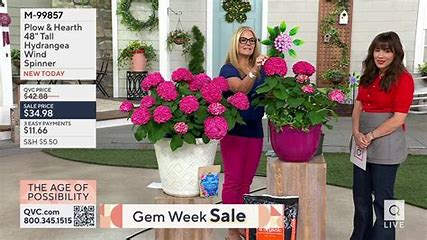
You may start reaching potential clients in your community and selling your do-it-yourself products online with the help of the methods mentioned above. Sell on multiple platforms simultaneously for optimal results. For instance, Linkup, Etsy, or Amazon Handmade on your website. Additionally, don’t pass up the chance to sell your handicrafts at neighbourhood markets!
Although marketplaces typically demand exorbitant fees, they can be excellent for attracting customers to your business. Having your own website is therefore essential for boosting your profit margins and fortifying your brand. In regards to local events, they enable you to cultivate a local clientele.
You may reach a larger audience and improve your chances of success as a do-it-yourself business owner by being active on many platforms. With so many possibilities, why restrict yourself to a single sales channel? For optimal exposure, think about utilising Ecwid’s e-commerce platform to effortlessly manage and sell your do-it-yourself goods through a variety of channels.
3. Local Markets and Craft Fairs
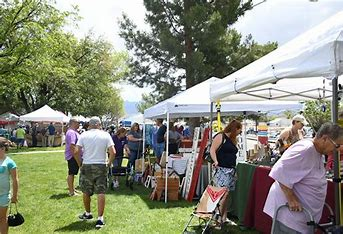
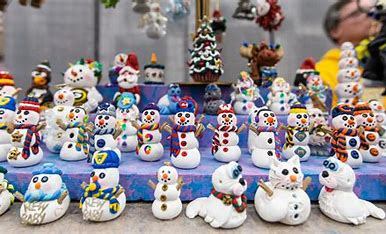
Local Markets and Craft Fairs: A Great Opportunity for DIY Sellers
Local markets and craft fairs are fantastic avenues for selling your DIY crafts and handmade products. These events provide a unique opportunity to connect with customers face-to-face, showcase your creativity, and build a local customer base. Whether you’re just starting or looking to expand your reach, participating in these events can help grow your brand and increase sales.
Here’s how to make the most out of local markets and craft fairs:
1. Find the Right Markets and Fairs
The first step in getting involved in local markets and craft fairs is to identify the right events. Here’s how you can choose:
- Target Audience: Look for markets that attract customers who are likely to be interested in your products. For example, if you make eco-friendly goods, search for green or sustainable living markets.
- Event Size: Consider the size of the market. Larger craft fairs will have a bigger footfall but may also be more competitive. Smaller, niche events can provide a more intimate atmosphere and less competition.
- Location: Focus on markets in areas where there’s a strong community presence and people are likely to attend regularly. High-traffic areas like town centers or popular tourist spots can increase your exposure.
- Theme: Many craft fairs or local markets have specific themes (e.g., holiday fairs, handmade goods, vintage items). Choose events that align with your products.
2. Prepare Your Display and Booth
Your booth at a craft fair is your storefront, so it’s essential to create a visually appealing and functional setup. Here’s how to stand out:
- Tables and Displays: Invest in tables, display stands, or shelving units that can showcase your products neatly. Display items at different heights to create visual interest.
- Branding: Make sure your booth has clear branding. Include your shop name, logo, and any other details that reflect your brand identity. This helps customers remember you after the event.
- Signs: Use professional signage that includes your business name, prices, and a short description of your craft. Well-organized signage makes it easier for customers to shop.
- Product Presentation: Display your products in an organized, clean way. Group similar items together or organize them based on color, size, or theme. Don’t overcrowd the booth—space allows products to “breathe” and be more inviting.
- Packaging and Bags: Have plenty of bags and packaging materials on hand to send customers home with their purchases in style. Consider offering eco-friendly packaging to align with sustainability trends.
3. Set Competitive and Fair Prices
When pricing your products for local markets and craft fairs, keep in mind:
- Costs: Factor in the cost of materials, your time, booth fees, and any other associated expenses. It’s important to price your items so you can cover your costs and make a profit.
- Market Rates: Check out what other vendors are charging for similar items. Ensure your pricing is competitive without undervaluing your work.
- Bundle Deals: Offering bundle deals or discounts for multiple purchases can encourage customers to buy more.
- Pricing Transparency: Display prices clearly at your booth. Customers appreciate knowing the cost upfront rather than having to ask.
4. Create an Engaging Customer Experience
Interacting with customers at craft fairs is one of the most rewarding parts of selling your DIY products. Here are some tips for a great customer experience:
- Be Friendly and Approachable: Greet customers with a warm smile and engage in conversations. Share the story behind your craft and what makes your products unique.
- Product Demonstrations: If possible, show how your products are made. Demonstrating your crafting process can attract more people and allow them to appreciate the effort and skill that goes into each item.
- Samples: If applicable, offer samples of your products, such as small candles or lotion testers, to give customers a preview of what they can expect.
- Customer Service: Provide excellent service by answering questions and being accommodating. Always offer assistance when needed and be patient with customers.
5. Take Payments Easily
Make it easy for customers to purchase from you by offering multiple payment methods:
- Cash: Some people prefer paying with cash, so have plenty of change on hand.
- Credit/Debit Cards: Use a mobile card reader like Square or PayPal Here to process credit card payments. These devices are easy to use and typically come with low transaction fees.
- Mobile Payments: Offering mobile payment options (like Venmo, Apple Pay, or Google Pay) is a good idea for tech-savvy customers.
6. Network and Build Relationships
Craft fairs and local markets are great places to meet other artisans and local business owners. Networking can be helpful for both personal and professional growth:
- Collaborate: Building relationships with other vendors can lead to future collaborations, joint promotions, or even just valuable advice from people who understand the craft business.
- Customer Relationships: Hand out business cards, and encourage customers to follow you on social media. Building relationships with customers can lead to repeat business and word-of-mouth referrals.
7. Use Social Media to Promote Your Appearance
Before the event, use your social media accounts to promote your participation. Here’s how:
- Event Announcements: Post about the event on platforms like Instagram, Facebook, and Twitter. Mention the event details, such as the date, time, location, and what you’ll be showcasing at the fair.
- Behind-the-Scenes Content: Share posts showing your preparation process—whether it’s making products, setting up your booth, or getting excited about meeting customers.
- Engagement: Engage with attendees and fellow vendors on social media. Use event hashtags, and tag the event organizers, so your posts can reach a wider audience.
8. Plan for Logistics
Make sure you’re prepared for the logistics of the day:
- Transportation: Plan how you’ll get all your products, displays, and other materials to the event. Use sturdy containers or carts to make transporting everything easier.
- Set-Up Time: Arrive early enough to set up your booth without feeling rushed. It’s better to have a little extra time than to be scrambling at the last minute.
- Weather Considerations: If the event is outdoors, be sure to bring tents, canopies, or tarps to protect your products from weather conditions like rain or strong sun.
9. Post-Event Follow-up
After the event, don’t forget to stay in touch with your new customers:
- Thank You Notes: Consider sending a follow-up message or email thanking customers for their purchase.
- Stay Active on Social Media: Post pictures from the event to keep the momentum going and engage with customers who visited your booth.
- Keep Track of Sales: Record the items that sold best at the fair. This information can help you fine-tune your inventory for future events.
Conclusion
Local markets and craft fairs provide an excellent opportunity for small business owners and DIY enthusiasts to get their products in front of customers in a personal, hands-on way. By preparing carefully, offering great customer service, and using these events to build relationships, you can turn these opportunities into a sustainable income stream. Whether you’re a seasoned crafter or just starting out, these events can be a fun and profitable addition to your business strategy. Happy selling!
4. Social Media


Share images and videos of your do-it-yourself goods on social networking sites like Facebook, Instagram, Pinterest, and TikTok to connect with potential buyers. These networks can also be used to engage with your audience, develop a fan base, and increase website traffic.
Use a link-in-bio tool, like Linkup, to make selling do-it-yourself products on social media easier. It enables you to make a mobile-friendly page that includes links to all of your information, social media accounts, and—above all—your items. This makes it simple for potential buyers to purchase your do-it-yourself goods directly from your social media profile.
Try a variety of social media outlets to determine which ones are most effective for your brand and target market. Don’t stick to just one. Additionally, you can easily observe which platforms generate the most sales in your Linkup by looking at the insights area.
5. Personalized Gifta
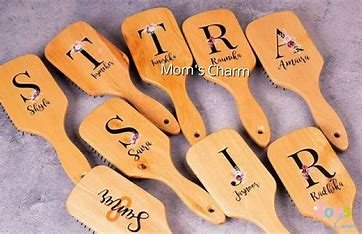
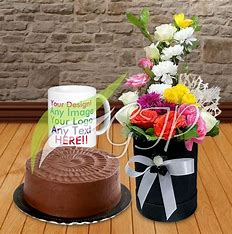
Personalized Gifts: A Growing Trend in Ecommerce
Personalized gifts have become one of the most sought-after categories in the gift industry. People love receiving items that feel unique and tailor-made just for them, whether it’s for a birthday, wedding, holiday, or special occasion. As a DIY seller, personalized gifts can be a great way to stand out in a crowded market and create meaningful connections with your customers.
Here’s how you can make personalized gifts a successful part of your business:
1. Types of Personalized Gifts You Can Offer
There are endless possibilities when it comes to creating personalized gifts. Here are some popular options to consider:
- Engraved Jewelry: Necklaces, bracelets, rings, and watches with names, initials, or special dates.
- Custom Mugs: Personalized mugs with names, quotes, or funny messages. These are perfect for people who love unique, custom items for their morning coffee.
- Personalized Home Decor: Custom signs, engraved wooden plaques, or photo frames with names, family crests, or inspirational quotes.
- Custom Apparel: T-shirts, hoodies, socks, or hats with embroidered names, initials, or custom designs.
- Personalized Stationery: Custom notebooks, planners, or greeting cards with personalized details such as names, monograms, or messages.
- Photo Gifts: Custom photo books, canvas prints, or pillows featuring personal pictures.
- Customized Kitchenware: Engraved cutting boards, personalized wine glasses, or custom aprons.
2. How to Create Personalized Gifts
Creating personalized gifts allows you to use your crafting skills to offer something that feels unique. Here’s how to approach it:
- Custom Engraving/Printing: Invest in a high-quality engraving tool, heat press, or printer for items like jewelry, mugs, and cutting boards. You can also outsource engraving or printing if you don’t have the equipment yourself.
- Handcrafted Elements: For items like jewelry, you can handcraft the base (e.g., making a necklace) and then personalize it with engraving or beading.
- Software for Design: Use design software like Adobe Illustrator, Canva, or Cricut’s Design Space to create custom graphics for your products. These tools help you design everything from monograms to unique illustrations.
3. Market Your Personalized Gifts
To successfully market your personalized gifts, you’ll need to tap into the emotions behind gift-giving. Here are some ideas:
- Highlight the Emotional Appeal: Personalization creates a deeper connection. Emphasize how your gifts are perfect for showing love, appreciation, or celebrating milestones. For example, showcase how a custom necklace or a framed family photo can make someone feel special.
- Seasonal Marketing: Focus on key holidays and events like Christmas, Valentine’s Day, Mother’s Day, Father’s Day, weddings, and birthdays. Customize your marketing campaigns to feature products that align with those occasions.
- Social Media and Influencers: Share your personalized creations on platforms like Instagram, Pinterest, and Facebook. Use hashtags like #PersonalizedGifts, #CustomGifts, or #GiftIdeas to increase visibility. Consider collaborating with influencers who can showcase your products in real life.
- Customer Testimonials and Photos: Encourage customers to share photos of their personalized gifts. Use those images as testimonials on your website and social media to show how your gifts bring joy to others.
4. Pricing Personalized Gifts
Pricing personalized items can be tricky, but it’s important to ensure you’re compensating for the time and effort you put into customization. Consider these factors when pricing:
- Materials Cost: Calculate the cost of raw materials (e.g., wood, fabric, metal) as well as any equipment or tools used for engraving or printing.
- Customization Fees: Charge an additional fee for personalization (e.g., for engraving names, adding custom designs, or creating personalized packaging).
- Time and Labor: Don’t forget to factor in the time you spend on personalizing the items. The more intricate the customization, the higher the price can be.
- Market Research: Look at similar personalized items online or in local stores. This will give you an idea of what customers are willing to pay and help you stay competitive.
5. Customer Experience and Engagement
Since personalized gifts are deeply tied to the emotions of the buyer, it’s essential to offer an excellent customer experience:
- Easy Customization Process: Make it simple for customers to specify what they want personalized on their gift. Provide clear options, such as a space for text (name, date, message) or a drop-down menu for design choices.
- Clear Communication: Make sure customers know exactly how the customization will look. Show mockups or examples on your website, and always confirm with them before proceeding with the personalization.
- Fast Turnaround Time: Personalized items can sometimes take longer to produce than standard products, so be clear about processing times. Offer expedited shipping for customers who need their items quickly.
- Packaging and Presentation: Packaging is just as important as the product itself. Consider offering gift wrapping or custom packaging to make the unboxing experience special. Personalized packaging adds an extra touch of thoughtfulness and care.
6. Selling Personalized Gifts Online
Ecommerce is a great platform for selling personalized gifts. Here’s how to make the most of it:
- Create a Professional Website: If you’re not already on a platform like Etsy or Shopify, consider creating your own website to sell your personalized gifts. Ensure the site is easy to navigate, with clear product photos and customization options.
- SEO (Search Engine Optimization): Optimize your website with keywords related to personalized gifts, such as “custom jewelry,” “personalized home décor,” or “unique gifts for her.” This helps your store rank higher in search engine results and attract organic traffic.
- Online Marketplaces: In addition to your website, consider listing your products on popular online marketplaces like Etsy, Amazon Handmade, or eBay, which have built-in customer bases looking for custom gifts.
- Upsell and Cross-sell: Suggest related items to customers when they’re making a purchase. For example, if someone buys a personalized mug, offer them a custom coaster or matching tea towel to go with it.
7. Expand Your Offerings
Once your personalized gift business is established, consider expanding your product line:
- Offer Different Personalization Methods: If you start with engraved items, you could add embroidery or laser cutting as personalization options.
- Create Gift Sets: Offer bundles of personalized products (e.g., a custom mug, a personalized notebook, and a pen). Gift sets are popular, especially around the holidays.
- Seasonal or Themed Gifts: Create themed gifts for specific events like weddings, baby showers, anniversaries, or retirement parties. Offering unique products for special occasions can make your shop stand out.
Conclusion
Personalized gifts are a powerful way to connect with customers and tap into the emotions behind meaningful gift-giving. Whether you’re making custom jewelry, home décor, or photo items, offering personalization gives you a competitive edge and builds customer loyalty. By focusing on quality, pricing, and a great customer experience, you can turn your personalized gifts into a thriving business.
Happy crafting, and may your creations bring joy to many!
6. DIY Kits
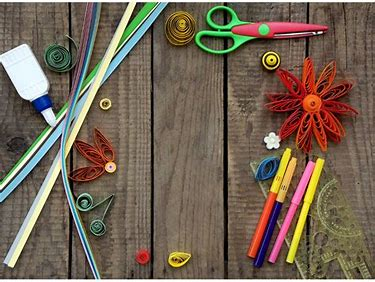
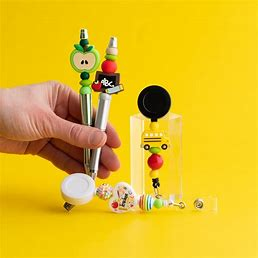
Making DIY kits is a great way to get into the do-it-yourself market. This enables you to provide your clients with a distinctive experience and, based on your kit, a finished product that they can be proud of that is completely customisable.
You may make your own car freshener kits, jewelry-making supplies, painting or pottery sets, or makeup or soap-making kits. Consider the types of do-it-yourself projects that your target audience might be interested in undertaking.
7. Blankets
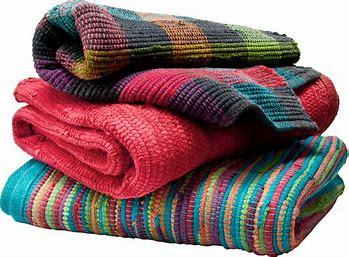
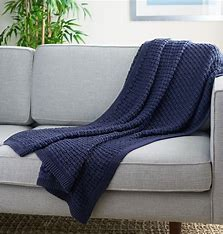
Selling blankets might earn you a lot of money if you can find a reliable source for yarn or cloth. Even though a blanket is cheap to manufacture, it may seem incredibly expensive with the correct design.
Learn how to make a warm blanket in ways that go beyond crocheting. Watch this instructional video for a motivational example.
8. Wooden Designs
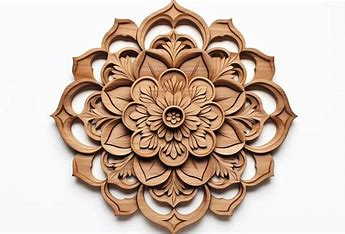
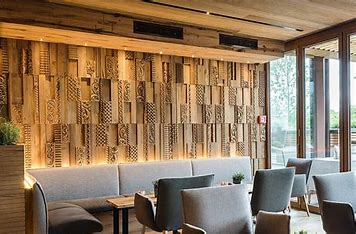
Wooden designs can refer to a wide range of artistic and functional creations made from wood. These can include furniture, decor, architecture, carvings, and more. Wooden designs are highly valued for their natural aesthetic, durability, and versatility. Some popular types of wooden designs include:
- Furniture Design: Wooden chairs, tables, cabinets, bookshelves, and other pieces of furniture often feature intricate carvings or sleek, modern lines.
- Wooden Wall Art: This can range from large-scale, abstract wooden sculptures to small, detailed carvings.
- Wooden Flooring: Various wood species and finishes are used to create elegant and timeless floors.
- Wooden Doors and Windows: Carved doors or windows with intricate patterns or simple designs add elegance to homes and buildings.
- Wooden Decor: Items like picture frames, clocks, and decorative bowls are often crafted from wood for a natural, rustic look.
- Wooden Jewelry: Wooden bracelets, earrings, and necklaces are popular for their eco-friendliness and unique patterns.
What kind of wooden designs are you interested in? Would you like some inspiration or tips on how to incorporate wooden elements into a design project.
9. Kids Toys
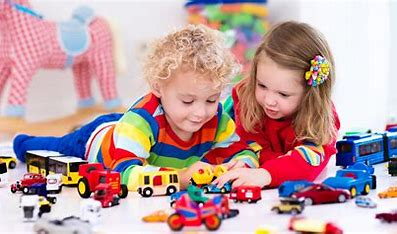
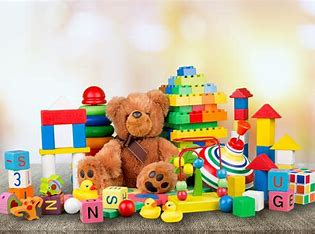
According to Statista, the average youngster in the United States spends $300 on toys annually as of 2025. That is a respectable amount of change. You can share your works with young children who will like your do-it-yourself products for years to come by making toys and other DIY projects for kids of all ages. Additionally, you are not required to be a manufacturer. To become the next great toymaker, all you need is some cloth, paint, and filling.
10. Resin Jewelry
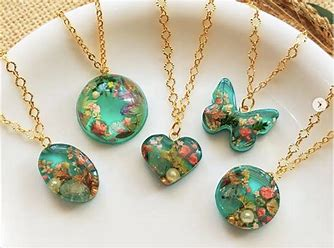
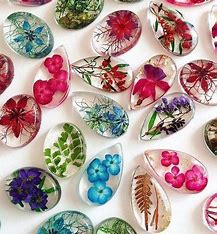
Resin jewelry is a popular and creative form of accessory design that uses resin as a primary material to encase various objects, create beautiful colors, and form unique shapes. It’s often a combination of art and craftsmanship, allowing for a wide range of designs, from simple to complex. Here are some key details about resin jewelry:
Types of Resin Jewelry
- Resin Pendant Necklaces: Resin can be molded into different shapes and designs, often featuring embedded items like flowers, glitter, gemstones, or even photos.
- Resin Earrings: These can come in various forms, from clear resin with tiny objects inside to bold, colorful, geometric, or abstract designs.
- Resin Rings: Resin rings often showcase a unique, glossy finish and can be combined with other materials like wood, metal, or stone.
- Resin Bracelets: These pieces can be solid or bangle-style and may incorporate designs like dried flowers, small trinkets, or colorful swirls.
- Resin Brooches: These can feature intricate designs and can serve as a bold statement piece on clothing.
How Resin Jewelry is Made
- Casting: Resin is typically poured into molds, where it hardens over time. While in its liquid form, artists may mix in pigments, dyes, or other materials (like dried flowers, glitter, or small beads) to create unique designs.
- Embedding Objects: Artists can embed various materials into the resin, such as dried flowers, shells, beads, stones, or even pieces of fabric.
- Polishing and Finishing: After the resin has cured (hardened), the piece is often sanded and polished to give it a smooth, glossy finish.
Benefits of Resin Jewelry
- Customization: Resin jewelry is highly customizable, offering endless possibilities for design, color, and texture.
- Lightweight: Compared to metals or stones, resin jewelry tends to be lightweight, making it comfortable for daily wear.
- Durability: Resin, when properly cared for, is quite durable and resistant to wear and tear.
Tips for Caring for Resin Jewelry
- Avoid Prolonged Sun Exposure: Over time, UV rays can cause resin to yellow, so it’s best to store your resin jewelry away from direct sunlight.
- Keep Away from Chemicals: Harsh chemicals can damage resin. It’s a good idea to remove resin jewelry before swimming in chlorinated water or applying lotions and perfumes.
- Clean with a Soft Cloth: Use a soft, non-abrasive cloth to gently clean your resin jewelry. Avoid using harsh chemicals or scrubbing it too hard.
Resin jewelry is a fun and versatile way to express creativity, and with the right techniques, it can become a unique, personalized accessory. Do you have a particular style of resin jewelry you’re interested in.
11. Printed Throw Pillows
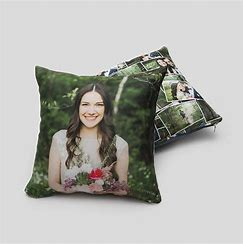
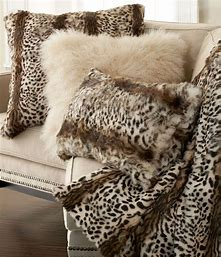
Did you know that the annual revenue from the home décor sector is approximately $62.5 billion? It’s accurate. Entering this market niche makes a lot of sense because of this, particularly if you have a totally original product, like throw pillows with custom printing. Personalised throw pillows let customers and gift buyers show off their individuality and sense of pride. Additionally, you can begin doing this at home rather than in a screen printing facility.
12. Cat Tents
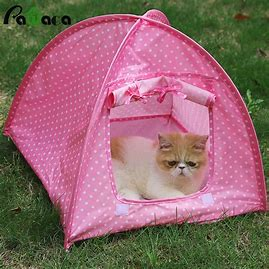
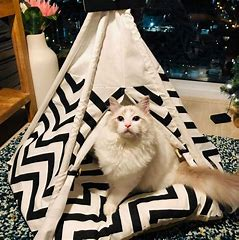
A cat tent is a small, portable shelter designed specifically for cats to relax, sleep, or play in. These tents offer a cozy and safe space for cats, often providing a retreat that mimics a natural hiding or resting area. They come in various styles, materials, and sizes to cater to different cat preferences. Here’s a breakdown of cat tents:
Types of Cat Tents
- Pop-Up Tents: These are lightweight, easy-to-assemble tents that “pop up” when opened. They’re perfect for cats who enjoy having their own space without much effort.
- Indoor Cat Tents: Designed to be used inside the house, these tents often feature soft fabrics, like fleece or plush, to create a comfortable resting spot for cats.
- Outdoor Cat Tents: These tents are more rugged and designed to be used outdoors. They can offer your cat a safe, enclosed space while they enjoy some fresh air, and some even feature mesh walls to allow for ventilation and protection from insects.
- Hanging Cat Tents: Some cat tents are suspended from a frame or other surface, offering a raised area for cats to relax. These are great for cats who love high vantage points.
- Covered Cat Tents: Some tents have a full cover that provides complete privacy for cats who enjoy being in enclosed spaces, offering them a sense of security and a cozy den-like environment.
Benefits of Cat Tents
- Comfort and Privacy: Cats love to have their own space to relax, and a cat tent provides them with a private area where they can feel safe and secure.
- Stress-Free Zone: A cat tent can serve as a retreat for cats that get easily stressed or overwhelmed by noise or other pets.
- Protection: Outdoor tents can protect your cat from harsh weather, bugs, and potential dangers while giving them the freedom to explore nature.
- Play and Exploration: Many cat tents come with toys or openings for cats to climb in and out of, providing entertainment and exercise opportunities.
Materials Used in Cat Tents
- Canvas: A durable, breathable material often used for outdoor tents.
- Plush/Fleece: Soft, comfortable fabrics perfect for indoor tents, providing a cozy space for napping.
- Mesh: Often used for ventilation, mesh allows for airflow and gives your cat a better view of their surroundings.
- Waterproof Materials: For outdoor tents, waterproof materials ensure that the tent remains dry during rainy weather.
How to Choose the Right Cat Tent
- Size: Consider your cat’s size and whether the tent needs to fit multiple cats. Larger tents are available for cats that prefer extra space.
- Location: Choose an indoor or outdoor tent based on where your cat will use it. Indoor tents are often smaller and made for comfort, while outdoor tents need to be more durable.
- Durability: Look for materials that can stand up to your cat’s scratching and play. If the tent will be used outdoors, make sure it’s weather-resistant and built to last.
Tips for Introducing a Cat Tent
- Place it in a Quiet Area: Position the tent in a quiet, calm spot so your cat feels safe and secure.
- Add Familiar Items: Put a favorite blanket or toy inside the tent to encourage your cat to explore it.
- Be Patient: Some cats may take time to adjust to their new tent. Leave the entrance open and let them approach it at their own pace.
Cat tents can be a fun and practical way to provide your cat with a cozy, private space to relax or play. Do you already have a cat tent, or are you considering getting one for your feline friend.
13. Milk Bath Kits
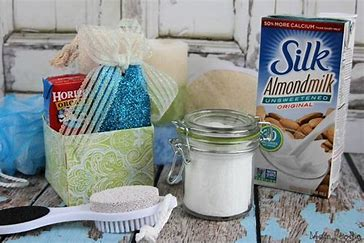
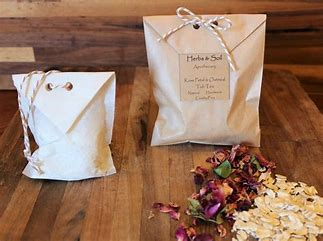
These days, bathtubs aren’t just for bubbles. Add salts, oils, teas, and jellies. And the milk bath is one of the newest methods for nourishing tired skin that is also surprisingly simple to prepare at home. All you’ll need to make a basic batch for your clients is powdered milk, baking soda, mineral salts, essential oils, and sometimes dried flowers.
Spend some time considering the packaging of your do-it-yourself crafts before you begin to consider how to market them. Packaging for milk baths should be both fashionable enough to convey the experience and waterproof (for obvious reasons). If using plain mason jars, adorn them with ribbons or labels. Your DIY products are more likely to be bought as gifts if they come in fancy packaging.
14. Dread Hair Extensions
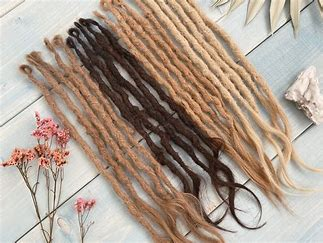
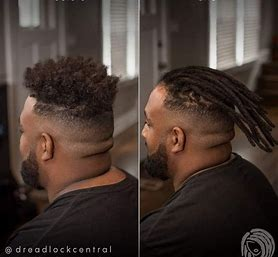
Dread hair extensions are a popular way to achieve the look of dreadlocks without having to go through the long process of growing and maintaining natural dreads. These extensions can be made from synthetic or natural hair and are often used by individuals who want to add volume, length, or texture to their existing dreads or create a full dreadlocked look.
Types of Dread Hair Extensions
- Synthetic Dread Extensions: These are the most common and affordable option. They are made from synthetic fibers that mimic the look and texture of real hair. Synthetic dreads are low-maintenance and come in various colors, lengths, and textures. They can be installed easily and are lightweight, making them ideal for those who want a temporary dreadlock style.
- Human Hair Dread Extensions: Made from real human hair, these extensions provide a more natural look and feel. Human hair dread extensions can be styled, dyed, and treated just like your natural hair. They are more expensive but offer better durability and a more authentic appearance.
- Crochet Dread Extensions: These are created by crocheting hair fibers into a lock, often using a crochet hook. The technique gives the dreads a more polished, neat, and tight look, which some people prefer for a more refined dreadlocked style.
- Wrapped Dread Extensions: These involve wrapping synthetic or human hair around a natural dreadlock to add length and texture. This method helps blend the extensions seamlessly with natural dreads and can also be used to add color or highlights to the hair.
Methods of Installing Dread Hair Extensions
- Braiding: One common way to install dread extensions is by braiding the natural hair and the extension together. This method helps secure the extension at the root and creates a natural transition.
- Crochet Method: A crochet hook is used to pull the extension hair through the natural hair, knotting the fibers together. This is often done to create tighter and more defined dreads.
- Twist and Rip Method: This method involves twisting sections of hair and then “ripping” them apart to create the dreadlock formation. Extensions can be added as you go along to increase the size or length of the dreadlock.
- Interlocking: This method involves using a specialized tool to weave the hair extensions into the existing dreadlock, helping the hair form tight, uniform locks.
Benefits of Dread Hair Extensions
- Instant Dreadlocks: One of the biggest benefits is that you can achieve dreadlocks immediately without waiting for your hair to grow or form naturally.
- Variety of Colors: Dread extensions come in a wide range of colors, allowing you to add streaks or highlights to your hair or go for a completely new look.
- Low Maintenance: Synthetic extensions, in particular, require minimal care and can be washed and styled easily.
- Temporary or Permanent: Extensions can be a temporary way to try out dreadlocks or a long-term commitment if you want the look for a while.
Maintenance of Dread Hair Extensions
- Washing: Dread extensions, especially synthetic ones, do not require frequent washing, but it’s important to keep them clean and free of buildup. Be gentle when washing to avoid unraveling the dreads.
- Tightening: Depending on the method used for installation, you may need to tighten or re-twist your dreads over time to maintain their appearance.
- Moisturizing: While synthetic hair doesn’t require much moisturizing, human hair extensions will benefit from regular hair care products like oils or creams to keep them soft and shiny.
- Avoiding Heat Styling: Synthetic dread extensions can be damaged by high heat, so it’s best to avoid using hot styling tools.
How Long Do Dread Hair Extensions Last?
- Synthetic Dread Extensions: These can last for several months if cared for properly. However, they may need to be replaced after some time, especially if they start showing wear or become frizzy.
- Human Hair Dread Extensions: These can last much longer, sometimes even years, depending on how well they are maintained and whether they are re-tightened or replaced.
Who Can Wear Dread Hair Extensions?
- Anyone Seeking a Dreadlock Look: Dread hair extensions can be worn by anyone who wants to experiment with the dreadlock style, whether it’s for a temporary change or a long-term commitment.
- Those Looking for Length and Volume: Extensions are ideal for people who want longer or thicker dreads without having to wait for their natural hair to grow.
- People with Different Hair Types: Dread extensions work on a variety of hair types and textures, but some methods may work better on certain hair types (e.g., crochet method works well for finer hair).
Dread hair extensions are a versatile, fun way to experiment with dreadlocks or enhance your existing ones. They offer an easy way to get the dreadlocked look without the time and effort of growing them naturally. Are you considering getting dread extensions, or are you already wearing them.
15. 3D Printed Products
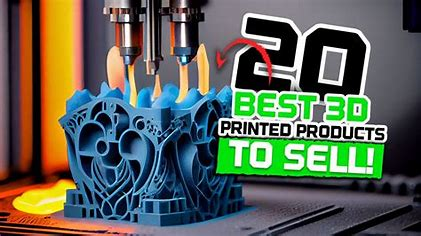
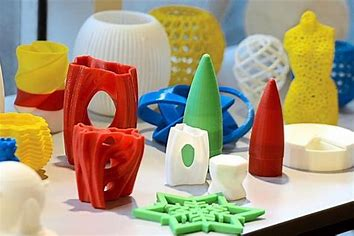
With 3D printing, the possibilities are virtually limitless. You can make personalised accessories and jewellery, collectibles and sculptures, or even one-of-a-kind home décor pieces. Even though purchasing a 3D printer could be more costly, there are several DIY ideas that might increase your profit margins. Choose tiny accessories like magnets, jewellery, and keychains.
16. Unique Craft Projects
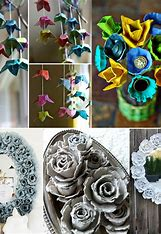
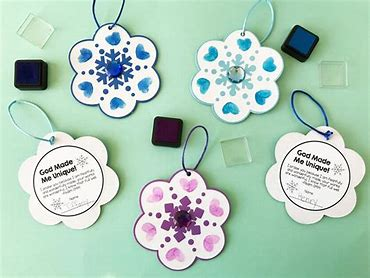
Here are some unique craft projects that you can try, whether you are a beginner or an experienced crafter. These projects will let you explore creativity, experiment with materials, and produce something beautiful or useful:
1. Resin Art
- What You Need: Epoxy resin, molds, pigments, glitter, dried flowers, beads, or other small objects.
- Idea: Create custom jewelry, coasters, trays, or wall art by pouring resin into molds and embedding decorative items like dried flowers, glitter, or small gemstones. You can experiment with different colors, textures, and designs to create a unique piece of art.
2. Macramé Plant Hangers
- What You Need: Macramé cord, wooden beads, metal rings.
- Idea: Use knotting techniques to create beautiful and functional plant hangers. You can make them in various sizes to hold different plants, adding a bohemian touch to any space. You can also incorporate wooden beads for extra decoration.
3. Upcycled Bottle Lamps
- What You Need: Empty bottles, string lights, a lamp kit (if making a stand), drill, or glue.
- Idea: Repurpose glass bottles into beautiful lamps by adding string lights inside. You can decorate the outside of the bottle with paint, lace, or fabric, creating a soft, ambient glow.
4. Hand-Painted Rocks
- What You Need: Smooth stones, acrylic paints, paintbrushes, varnish.
- Idea: Paint unique designs, animals, or motivational quotes on small rocks. These make excellent garden ornaments or thoughtful gifts. You could also create a rock collection and hide them around your community as part of a “rock hunt.”
5. DIY Embroidered Wall Art
- What You Need: Embroidery hoop, fabric, embroidery floss, needle.
- Idea: Stitch beautiful, intricate designs on fabric to create one-of-a-kind wall hangings. Whether you prefer geometric patterns, florals, or personalized quotes, embroidery can create unique and vibrant pieces of art.
6. Scented Sachets
- What You Need: Fabric, dried flowers (lavender, rose petals, etc.), sewing kit, ribbon.
- Idea: Make small fabric pouches filled with dried flowers and herbs to create fragrant sachets. You can place them in drawers, closets, or even use them as gifts. Personalize them with different scents and designs.
7. Upcycled Denim Bags
- What You Need: Old denim jeans, scissors, sewing machine, thread, buttons, or patches.
- Idea: Repurpose old denim into stylish bags or purses. You can add fun patches, embroidery, or studs to give your new bag personality. This is a great way to reduce waste and create something unique and fashionable.
8. DIY Terrariums
- What You Need: Glass containers (like jars or old fish tanks), plants (succulents, air plants, etc.), pebbles, sand, moss, decorative pieces.
- Idea: Create a miniature garden inside a glass container. Arrange your plants, moss, and decorative elements, and create a peaceful, natural scene. These terrariums are low maintenance and can add a touch of nature to any room.
9. Handmade Candles
- What You Need: Wax (soy, beeswax, etc.), wick, essential oils (for fragrance), containers (mason jars, glass cups), dye.
- Idea: Make your own candles with personalized scents and colors. You can experiment with adding dried flowers, glitter, or even creating layered candles with different fragrances.
10. Clay Pot Sculptures
- What You Need: Air-dry clay or polymer clay, paint, sculpting tools.
- Idea: Use clay to create small sculptures like animal figures, plants, or abstract art pieces. Once they dry, paint them with vibrant colors or metallic finishes to enhance their visual appeal.
11. Customized Tote Bags
- What You Need: Plain canvas tote bags, fabric paints, stencils, or embroidery thread.
- Idea: Personalize plain tote bags with your own designs. You can paint patterns, add quotes, or embroider colorful designs. Tote bags make excellent gifts or a functional accessory for yourself.
12. Handmade Soap
- What You Need: Soap base (glycerin, shea butter, etc.), essential oils, colors, molds, dried flowers, or herbs.
- Idea: Make your own custom soaps in fun shapes, colors, and scents. You can infuse them with dried flowers or herbs like lavender, chamomile, or rose petals for added beauty and fragrance.
13. Beaded Jewelry
- What You Need: Beads, wire, jewelry clasps, pliers.
- Idea: Create unique necklaces, bracelets, or earrings by stringing beads together in intricate patterns. You can experiment with different colors, shapes, and sizes of beads to create one-of-a-kind pieces of jewelry.
14. Pressed Flower Art
- What You Need: Fresh flowers, pressing materials (books or flower press), frame or canvas.
- Idea: Press flowers to preserve their color and form, then create beautiful wall art or bookmarks by arranging them on paper or canvas. This timeless craft captures the beauty of nature.
15. Personalized Keychains
- What You Need: Keychain blanks (wood, acrylic, or metal), paint or markers, charms, hot glue gun.
- Idea: Create personalized keychains with names, initials, or fun designs. You can use wood slices, acrylic blanks, or metal for a stylish and functional accessory.
16. Leather Crafting
- What You Need: Leather sheets, cutting tools, leather dye, rivets, stitching materials.
- Idea: Try making wallets, keychains, bookmarks, or even custom leather bags. Leather crafting allows for a variety of projects, and you can personalize your creations with initials or designs.
17. Paper Mâché Bowls or Sculptures
- What You Need: Paper, glue, balloon or mold, paint.
- Idea: Create bowls or sculptures by applying layers of paper mâché over a mold (like a balloon). Once dry, paint and decorate them to create functional or artistic pieces.
These craft ideas offer endless possibilities for creative expression and can be adapted to suit any skill level or personal style. Whether you’re looking to create a decorative piece for your home or a thoughtful gift for a loved one, these projects can bring out your inner artist. Do any of these projects inspire you to try something new.
17. Car Freshies
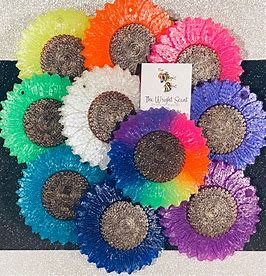
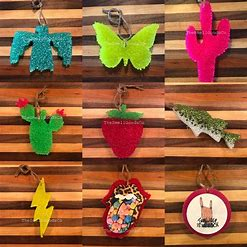
Give the areas where individuals spend the most time, like their cars, a little personal touch. You can provide clients a unique perfume for their car with car freshies because they have a unique scent that makes them stand out from other air fresheners on the market.
Aroma beads, essential oils, moulds, paints, and string are required to create these adorable do-it-yourself items.
18. Wall Art
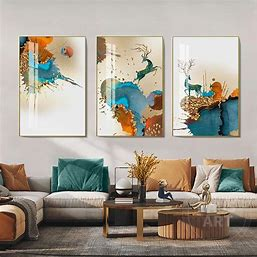
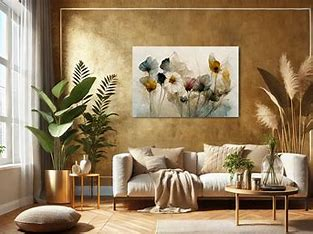
Wall art is an easy and impactful way to decorate a space, express personal style, and transform any room. From paintings and prints to DIY crafts and wall decals, the options for wall art are endless. Here are some unique and creative wall art ideas you can try:
1. Framed Prints
- What You Need: A favorite photograph, art print, or inspirational quote, and a frame.
- Idea: Choose your favorite prints or artwork and frame them to create a stylish, minimalist look. You can mix and match different frames for a gallery wall or opt for uniform frames for a clean, cohesive appearance.
2. Canvas Paintings
- What You Need: Canvas, acrylic paints, paintbrushes.
- Idea: Create your own masterpiece by painting a canvas. Whether you prefer abstract designs, landscapes, or a simple geometric pattern, hand-painted canvas art brings a personal and unique touch to your wall.
3. Wall Decals or Stickers
- What You Need: Peel-and-stick wall decals or custom vinyl stickers.
- Idea: Wall decals are a quick and easy way to decorate without the commitment of painting. Choose from a variety of designs, including quotes, nature scenes, geometric patterns, or even custom decals that represent your personality.
4. Macramé Wall Hangings
- What You Need: Macramé cord, a wooden dowel, and basic knotting skills.
- Idea: Add a bohemian touch to your wall with a hand-knotted macramé hanging. You can create intricate patterns with different knots and designs, adding texture and dimension to your space.
5. Gallery Wall
- What You Need: A mix of artwork, photos, and frames in various sizes.
- Idea: Arrange a collection of artwork, personal photographs, and prints into a stylish gallery wall. This design is perfect for showcasing your favorite pieces and can be tailored to fit any room or theme.
6. Wooden Wall Art
- What You Need: Wooden panels, wood stain, paint, nails, or screws.
- Idea: Create a rustic or modern look with wooden art. You can use reclaimed wood to craft geometric shapes, abstract patterns, or even inspirational quotes. The natural texture of the wood adds a warm, organic element to any space.
7. Tapestries
- What You Need: A fabric tapestry (can be purchased or DIY).
- Idea: Hang a large fabric tapestry to create a statement piece. Tapestries come in a variety of designs, from boho and tribal to modern and minimalist, and can cover an entire wall or be used as an accent.
8. Framed Fabric or Textiles
- What You Need: Colorful fabrics or vintage textiles, frames.
- Idea: Use beautiful fabrics or old scarves and frame them for a unique, textile-based wall art. The rich textures and patterns will bring color and interest to your walls.
9. 3D Wall Art
- What You Need: Paper, wood, foam, or metal shapes.
- Idea: Create a dynamic 3D wall art piece by layering different materials. You can make paper flowers, geometric shapes, or abstract sculptures that stand out from the wall, adding depth and dimension.
10. Mirror Art
- What You Need: Small mirrors, glue, and a backing board.
- Idea: Arrange small mirrors in unique patterns to create a reflective, eye-catching piece of art. You could create geometric designs, flowers, or any pattern that fits your style.
11. Vintage Posters
- What You Need: Vintage movie, music, or travel posters and frames.
- Idea: Add a touch of nostalgia with vintage posters. These can be framed or used as part of a larger wall collage. They evoke a sense of history and can add character to any room.
12. Hanging Planters as Art
- What You Need: Small hanging planters, plants, hooks.
- Idea: Combine your love for plants and wall art by creating a vertical garden. Use small planters or air plants suspended from the wall using macramé hangers or decorative hooks.
13. Framed Botanical Art
- What You Need: Dried flowers or leaves, glass frames.
- Idea: Press and frame your favorite flowers, leaves, or plants for a botanical-style wall art. This can bring the beauty of nature indoors while creating a tranquil atmosphere.
14. Photo Collage
- What You Need: A mix of personal photographs, photo frames, or corkboard.
- Idea: Display a collection of your favorite photos in a grid or collage format. You can highlight family moments, travel memories, or create a themed photo wall to showcase your personality.
15. Wall Shelves with Decorative Objects
- What You Need: Floating shelves, small decorative objects (plants, sculptures, books).
- Idea: Install floating shelves on your wall and place decorative items like plants, vases, books, or sculptures. This not only serves as wall art but also provides additional storage or space for personal items.
16. Chalkboard Wall Art
- What You Need: Chalkboard paint or a large chalkboard.
- Idea: Paint a section of your wall with chalkboard paint or install a large chalkboard. This gives you the freedom to change your wall art regularly, drawing new designs or writing inspirational quotes.
17. Abstract Paper Art
- What You Need: Colorful paper, scissors, glue, and a frame.
- Idea: Create a layered paper art design with different colors and textures of paper. This can be done in an abstract style or even with cut-out shapes and patterns that create depth and interest.
18. Upcycled Art
- What You Need: Recycled materials (old magazines, metal, wood, glass).
- Idea: Repurpose materials you have lying around the house, like old magazines, wood pieces, or even bottle caps, to create one-of-a-kind wall art. This sustainable approach brings a creative and eco-friendly element to your space.
19. Lightbox Art
- What You Need: A lightbox, design or photo, and LED lights.
- Idea: Create a glowing wall art piece by using a lightbox. You can place your favorite designs, artwork, or photos inside, and the LED lights will illuminate them, creating a stunning effect.
20. Shadow Boxes
- What You Need: Shadow boxes, small keepsakes, or memorabilia.
- Idea: Arrange sentimental items like tickets, photos, and souvenirs in shadow boxes. These pieces add a personal touch to your wall and are a great way to preserve memories in a creative way.
These wall art ideas are just the beginning, and you can mix and match different materials and techniques to create something truly unique for your space. Whether you prefer modern, minimalist, boho, or vintage styles, there’s a wall art project that can help you express your personality. Do any of these ideas stand out to you?
19. Ceramics
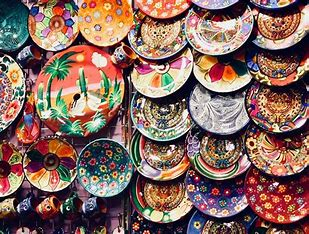
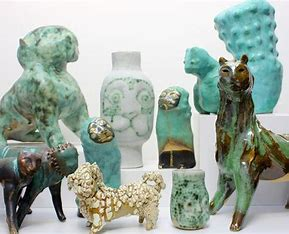
Although ceramics may appear to be an advanced art medium, you can begin by creating a basic bowl. Consider starting with simply your hands and your home oven instead of a wheel and pricey equipment to fire your do-it-yourself products. Once more, in contrast to the pristine bowls spun with centrifugal force, many customers find this rough appearance to be authentic and intriguing.
You may transform your do-it-yourself ceramic creations into works of art by using nail polish, glitter, or acrylic paint. You can see how easy it can be by watching the video.
20. Electronic Cases
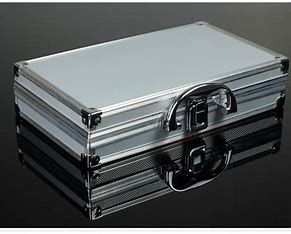
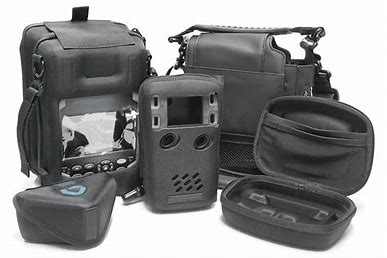
Electronic cases are protective covers designed to safeguard electronic devices from damage due to drops, scratches, dirt, dust, or accidental spills. They come in various types, shapes, and materials to cater to different types of devices, such as smartphones, tablets, laptops, and gaming consoles. Here’s an overview of the types of electronic cases available, along with their uses and benefits:
Types of Electronic Cases
1. Phone Cases
- Purpose: To protect smartphones from drops, scratches, and other damage while enhancing the appearance and grip.
- Types:
- Slim Cases: Offer minimal protection while maintaining the device’s sleek design.
- Rugged Cases: Provide extra durability with features like reinforced corners, shock absorption, and water resistance.
- Wallet Cases: Combine a phone case with a wallet, offering slots for credit cards, IDs, and cash.
- Battery Cases: Equipped with an internal battery to provide extra power to your phone, perfect for long trips.
- Flip Cases: Feature a flap that covers the front of the phone, providing additional screen protection.
2. Tablet Cases
- Purpose: To protect tablets from impacts and scratches while making them easier to carry.
- Types:
- Folio Cases: These cases fold like a book, offering front and back protection. Many have built-in stands for easy viewing.
- Keyboard Cases: Combine the protection of a folio case with a built-in keyboard, turning your tablet into a mini laptop.
- Sleeve Cases: Offer soft, padded protection, great for protecting your tablet while storing it in a bag.
- Shockproof Cases: Built to withstand drops and bumps, often used for protecting tablets used by kids or in rugged environments.
3. Laptop Cases
- Purpose: To shield laptops from scratches, impacts, and other potential damage while on the move.
- Types:
- Sleeve Cases: Soft, slim, and typically made from neoprene, sleeve cases offer a snug fit for laptops and are perfect for storing inside a larger bag.
- Hard Shell Cases: These provide rigid protection and are often custom-fitted for specific laptop models, offering defense against drops and bumps.
- Backpacks with Laptop Compartments: These feature dedicated, padded sections to keep your laptop safe while offering extra space for other items.
- Messenger Bags: Similar to backpacks, but with a cross-body design. They often have a padded section for laptops.
4. Gaming Console Cases
- Purpose: To protect handheld gaming consoles (like the Nintendo Switch or PlayStation Portable) or gaming accessories.
- Types:
- Hard Shell Cases: Offer maximum protection for gaming consoles and accessories, often featuring custom foam interiors for a snug fit.
- Carrying Cases: These cases are typically soft and designed for easy portability, with compartments for game cartridges and cables.
- Travel Cases: Often larger and equipped with handles or shoulder straps, these are designed for long trips and can hold the gaming console, accessories, and even additional games.
5. Camera Cases
- Purpose: To protect digital cameras or lenses from bumps, drops, and weather elements.
- Types:
- Hard Shell Cases: Provide maximum protection and are often waterproof, keeping the camera safe from the elements.
- Soft Cases: These are more lightweight and often come with internal compartments for extra memory cards and accessories.
- Shoulder Bags: Offer the most storage space, designed for photographers who need to carry cameras, lenses, and other accessories in one bag.
6. Headphone Cases
- Purpose: To protect headphones, especially over-ear models, from scratches, damage, and dust.
- Types:
- Hard Cases: Offer strong protection for headphones, often with a molded interior to keep them in place.
- Soft Pouches: Lightweight and flexible, these cases provide basic protection and are easy to store in bags.
- Travel Cases: Equipped with space for extra accessories like charging cables and adapters.
Materials Used in Electronic Cases
- Silicone: Soft, flexible, and shock-absorbent. Silicone cases are great for adding grip and cushioning.
- Polycarbonate: Rigid and durable, often used in hard cases to provide excellent protection from drops.
- Leather: Offers a premium look and feel, and is commonly used for wallet cases or folio cases.
- Neoprene: A stretchy, water-resistant material, often used in sleeve cases for laptops and tablets.
- Aluminum or Metal: Offers sturdy, long-lasting protection, typically used for hard shell or rugged cases.
- Fabric: Often used in soft cases or laptop bags, fabric provides light protection and style.
Benefits of Electronic Cases
- Protection: The primary function of electronic cases is to shield your device from damage, including drops, impacts, and scratches.
- Durability: Many cases are designed to extend the lifespan of your devices, especially if they are used in rough environments.
- Style: Cases come in various colors, designs, and materials, allowing you to personalize your devices to reflect your personality.
- Portability: Many cases come with handles, straps, or compartments that make carrying your devices more convenient.
- Organizational Benefits: For devices like tablets, laptops, and gaming consoles, cases often include extra storage for accessories, cables, and games.
How to Choose the Right Case
- Compatibility: Make sure the case is specifically designed for your device model to ensure a perfect fit and proper access to ports and buttons.
- Protection Level: Consider how much protection you need. If you’re prone to dropping your device, a rugged or shockproof case may be the best option.
- Design Preferences: Choose a case that matches your personal style, whether you prefer something minimalistic, colorful, or professional.
- Portability: If you travel often, look for a case with extra compartments or a built-in stand for added convenience.
- Material: Depending on your needs, choose between soft, flexible cases for comfort, or hard shell cases for maximum protection.
Conclusion
Electronic cases are an essential accessory for protecting your devices while keeping them looking stylish and functional. With so many different types and designs, you’re sure to find the perfect case to suit your needs, whether you want extra protection, portability, or simply a more personalized look for your electronics. Do you need help finding the perfect case for a specific device, or are you interested in a particular style?
21. Headbands


Because they are simple to produce and enjoyable to experiment with, headbands are excellent do-it-yourself products to sell online. Uncertain about how to create a headband? No issue. Numerous internet tutorials are available, some of which don’t even call for sewing. Headbands are a fashionable and safe option if you’ve been searching for a craft that requires no effort.
22. Coasters
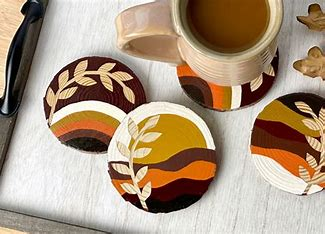
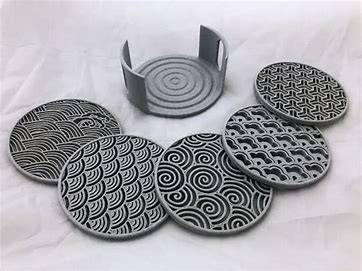
Coasters are small, flat items used to protect surfaces like tables and countertops from hot, cold, or damp drinks. They help prevent water rings, scratches, and stains on furniture while adding a decorative touch to your home. Coasters come in a variety of materials, designs, and sizes, making them a great way to showcase your personal style. Here are some ideas and materials for coasters, along with DIY tips for creating your own:
Types of Coasters
1. Wooden Coasters
- Material: Wood (often bamboo, oak, or maple).
- Benefits: Wooden coasters are durable, provide a natural aesthetic, and are eco-friendly. They can be easily customized with staining, painting, or engraving.
- Design Ideas: Rustic designs, minimalist geometric shapes, or personalized engravings.
2. Cork Coasters
- Material: Cork.
- Benefits: Lightweight, absorbent, and eco-friendly. Cork coasters are great at soaking up moisture and protecting surfaces from watermarks.
- Design Ideas: Simple, natural look with options for adding decorative prints or custom text.
3. Stone Coasters
- Material: Slate, marble, granite, or sandstone.
- Benefits: These coasters are highly durable and absorbent. Stone coasters often feature a more elegant, polished appearance, making them ideal for formal settings.
- Design Ideas: Polished surfaces, etched designs, or marble finishes.
4. Ceramic Coasters
- Material: Ceramic or porcelain.
- Benefits: Ceramic coasters are available in many patterns, colors, and textures. They are easy to clean and can often be found with a cork or rubber backing to prevent slipping.
- Design Ideas: Hand-painted designs, decorative patterns, or custom photos.
5. Glass Coasters
- Material: Glass.
- Benefits: Glass coasters can have sleek, modern designs and are often used for upscale settings. They can be clear, frosted, or etched with patterns.
- Design Ideas: Elegant patterns, personalized engraving, or vibrant colored glass.
6. Fabric Coasters
- Material: Cotton, linen, or felt.
- Benefits: Soft, flexible, and often washable, fabric coasters offer a unique texture and feel. They’re great for casual or cozy settings.
- Design Ideas: Quilted patterns, seasonal designs, or personalized monograms.
7. Silicone Coasters
- Material: Silicone rubber.
- Benefits: Flexible, non-slip, and heat-resistant. Silicone coasters are easy to clean and available in many fun shapes and colors.
- Design Ideas: Modern, minimalist designs or playful shapes like animals or geometric patterns.
DIY Coasters Ideas
1. Custom Wooden Coasters
- Materials Needed: Wooden discs, wood stain, paint, or woodburning tools.
- Instructions: Start with unfinished wooden discs or slices. Stain or paint them to your liking, or use a woodburning tool to engrave names, quotes, or designs. Finish with a clear varnish for protection.
2. Photo Coasters
- Materials Needed: Coaster blanks (wood, ceramic, or cork), photos, mod podge, scissors, and a clear sealer.
- Instructions: Cut out your favorite photos to fit the coaster size. Apply a thin layer of Mod Podge to the coaster and carefully place the photo. Once dry, apply a clear sealer to protect the photo and give the coaster a finished look.
3. Resin Coasters
- Materials Needed: Epoxy resin, silicone molds, glitter, dried flowers, or other small embellishments.
- Instructions: Mix the resin according to the instructions, and pour it into silicone molds. You can add glitter, dried flowers, or even colored pigments for a personalized touch. Allow it to cure completely before using.
4. Painted Ceramic Coasters
- Materials Needed: Ceramic tiles, acrylic paints, brushes, clear acrylic spray.
- Instructions: Paint designs or patterns onto ceramic tiles. You can use stencils or freehand your artwork. Once the paint is dry, seal the coasters with a clear acrylic spray to make them waterproof.
5. Cork Coasters with Fabric
- Materials Needed: Cork coasters, fabric, glue, scissors.
- Instructions: Cut fabric into small squares or circles that match the size of your coasters. Apply fabric glue to the top of the cork coaster and place the fabric on top. Press down firmly and let dry.
Benefits of Coasters
- Surface Protection: Coasters prevent water rings, heat marks, and scratches from damaging your furniture.
- Design Element: Coasters can be a fun and practical way to express your style. They come in a variety of materials and designs that can match the décor of any room.
- Gift Ideas: Personalized coasters make great gifts for birthdays, weddings, or housewarmings.
- Easy to Clean: Many coasters, especially those made of cork, ceramic, and glass, are easy to wipe clean and maintain.
How to Choose the Right Coasters
- Material: Choose based on the aesthetic you prefer (e.g., wood for rustic, glass for modern, cork for eco-friendly).
- Size: Ensure the coaster is large enough to hold your drink, but not so large that it overpowers the table.
- Design: Go for coasters that fit the style and mood of your home—whether that’s playful, minimalist, vintage, or elegant.
- Functionality: Consider if you need coasters with added functionality, like absorbent properties, heat resistance, or non-slip backing.
Conclusion
Coasters are both functional and decorative, protecting surfaces while adding style to your space. Whether you prefer DIY projects or store-bought designs, you can find coasters that reflect your personality and elevate your home décor. Would you like to explore more coaster-making techniques or designs?
23. Handmade Soap
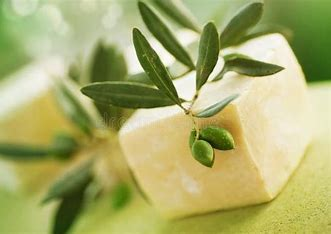
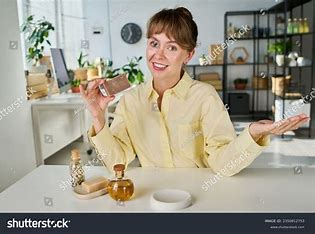
Consumers’ desire to use safe, organic cleaning products on a daily basis is growing. Profit from this trend by producing and selling your own do-it-yourself, handmade goods, such as hand soap. You can buy supplies to make soap and begin manufacturing original do-it-yourself items to offer in this market with a small initial expenditure.
Like candles, everything that makes a host or hostess, sister or uncle feel pampered is appreciated. The incredible range of fragrances and dyes makes it simple to create do-it-yourself goods for niche markets.
24. Tote Bags
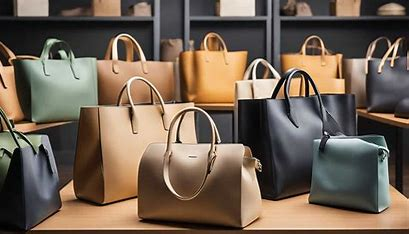
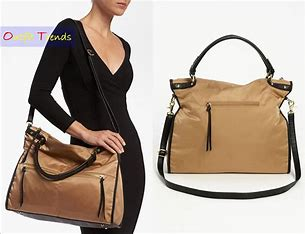
Tote bags are versatile, stylish, and functional accessories that are typically used for carrying items like groceries, books, or personal belongings. They are usually made of sturdy materials like canvas, cotton, or jute, and are designed with two handles, making them easy to carry over the shoulder or by hand.
Tote bags have become popular for a variety of reasons:
- Eco-friendly: They are often seen as a sustainable alternative to single-use plastic bags.
- Fashion statement: Many tote bags feature eye-catching designs, logos, or artwork, making them a trendy accessory.
- Practicality: Their large, open design makes them great for organizing and carrying items of various sizes.
Do you use tote bags often? If so, do you have a favorite type or design?
25. Pet Toys
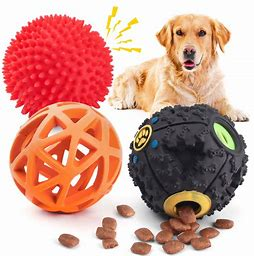

According to the APPA, the pet sector spends about $60 billion annually. It goes without saying that people adore their dogs and are willing to spend money to keep them happy. By producing eco-friendly, handcrafted pet toys from inexpensive recycled materials, you can take advantage of this enormous market. For these do-it-yourself crafts, there are numerous YouTube video lessons available.
26. Planters
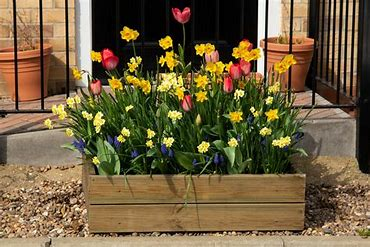
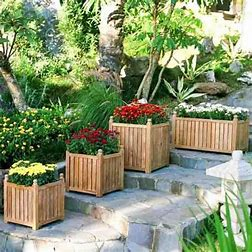
Planters are containers used to grow plants, typically made from materials like ceramic, plastic, wood, or metal. They come in various shapes, sizes, and styles, and can be used both indoors and outdoors. Planters help create an environment for plants to thrive by providing a designated space for their roots while allowing proper drainage to avoid waterlogging.
Some key types of planters include:
- Indoor Planters: These are usually smaller and can be decorative to complement interior design. They might include materials like ceramic, terracotta, or lightweight plastic. Popular plants for indoor planters include succulents, ferns, and houseplants like snake plants or pothos.
- Outdoor Planters: These are generally larger and made from more durable materials to withstand the elements. Common materials for outdoor planters include stone, concrete, or treated wood. They’re great for plants like flowers, shrubs, or even small trees.
- Hanging Planters: These planters are designed to be suspended, typically from hooks or ceilings, and are a great way to save space. They’re perfect for trailing plants like ivy or ferns.
- Self-Watering Planters: These feature a built-in reservoir that allows plants to take up water as needed. They are a good option for people who might forget to water their plants regularly.
- Raised Garden Planters: These are elevated planters that allow you to grow vegetables or flowers in a more ergonomic and accessible way, especially useful for those who may have difficulty bending down.
Planters not only serve a functional purpose but also add beauty to spaces, helping to create a relaxing and green environment.
Are you looking for a specific type of planter or tips for certain plants?
 Create Craft
Create Craft